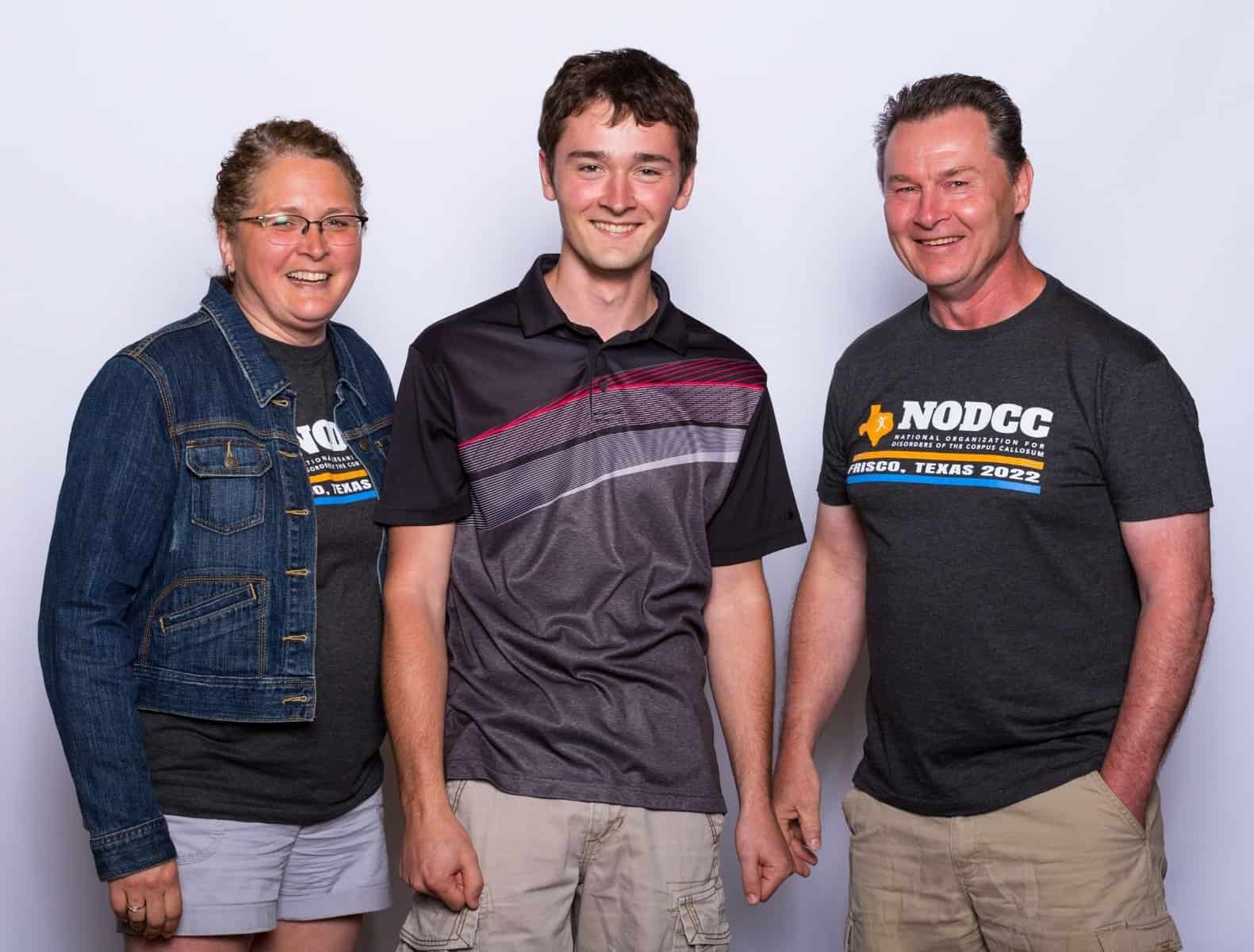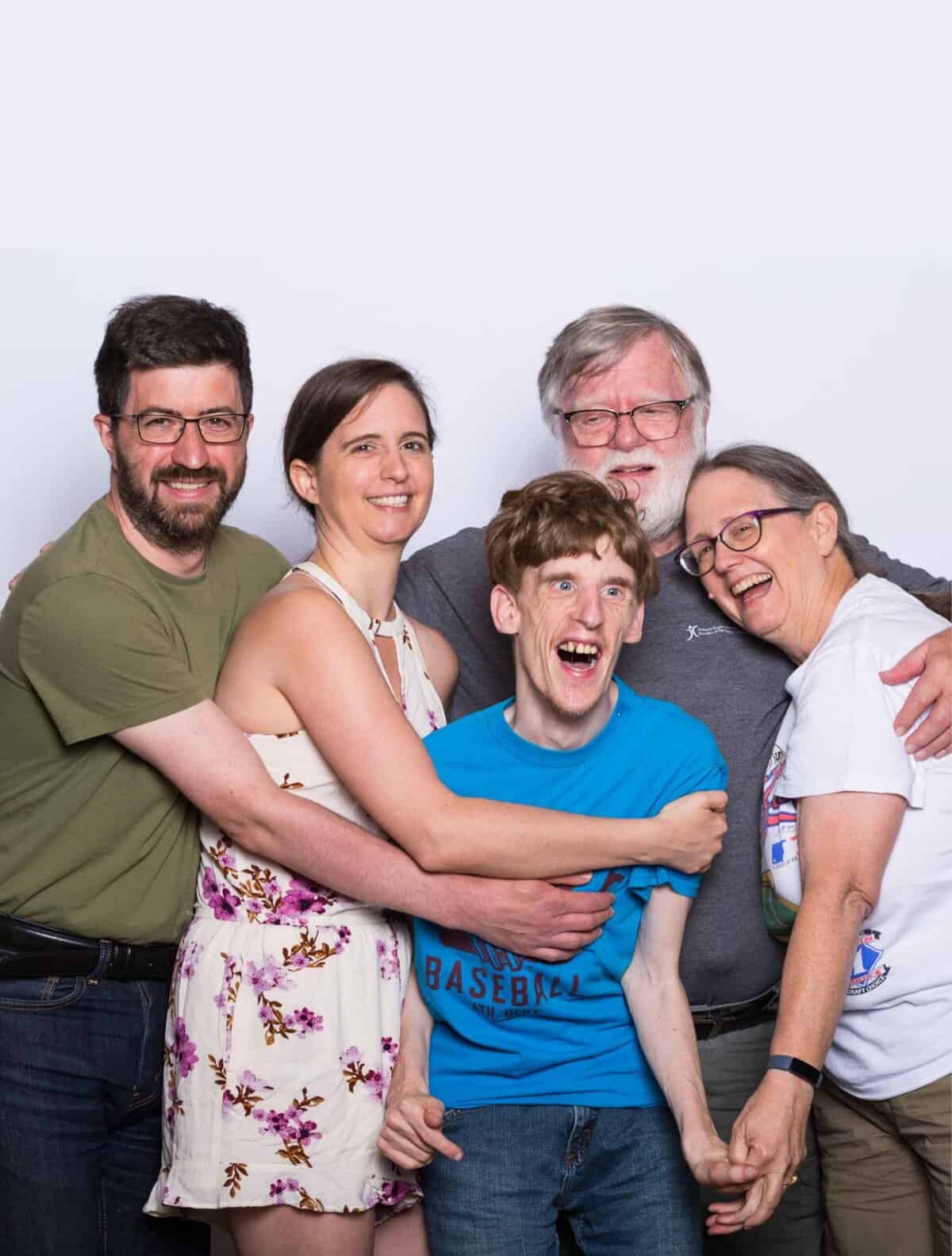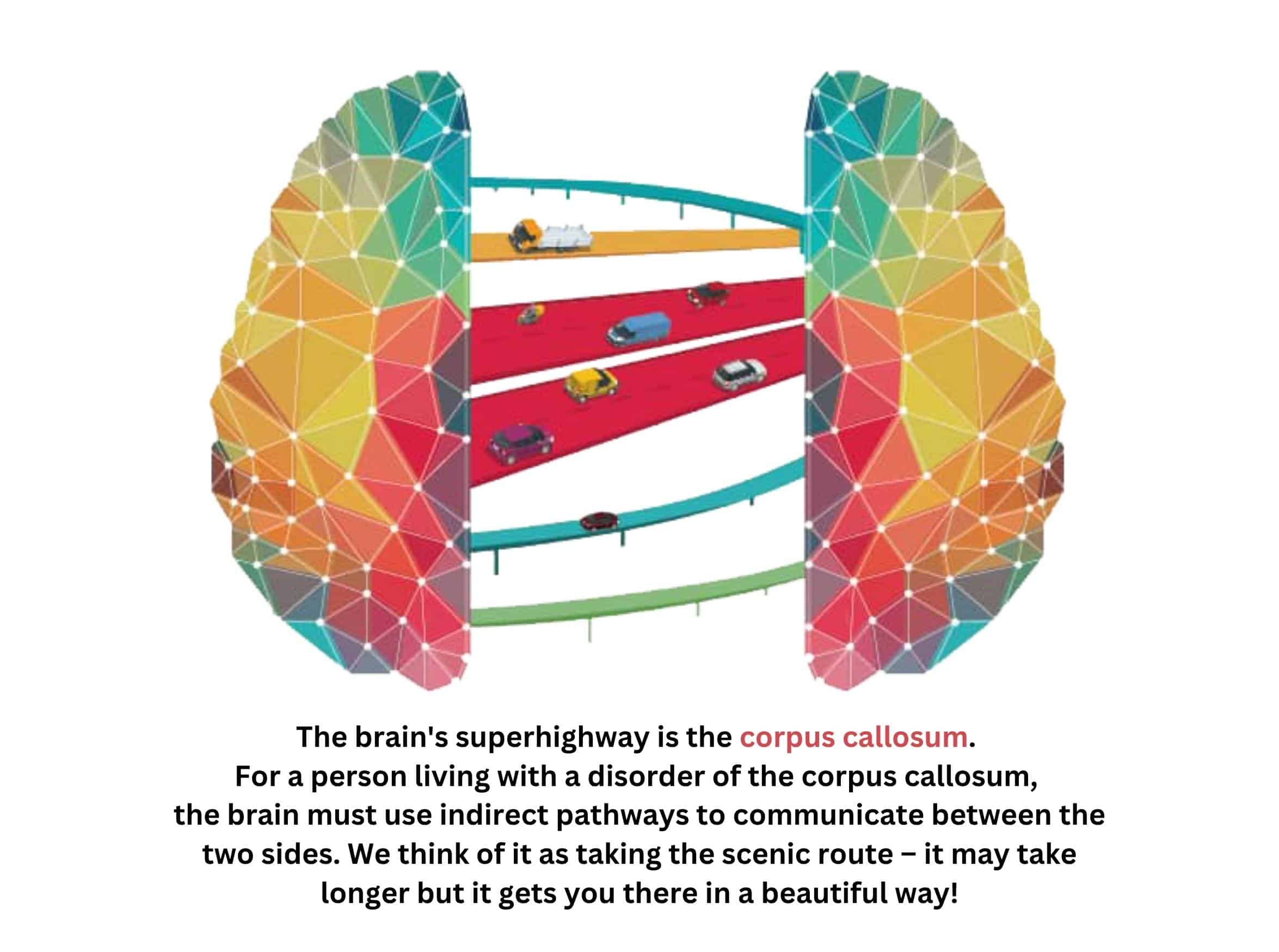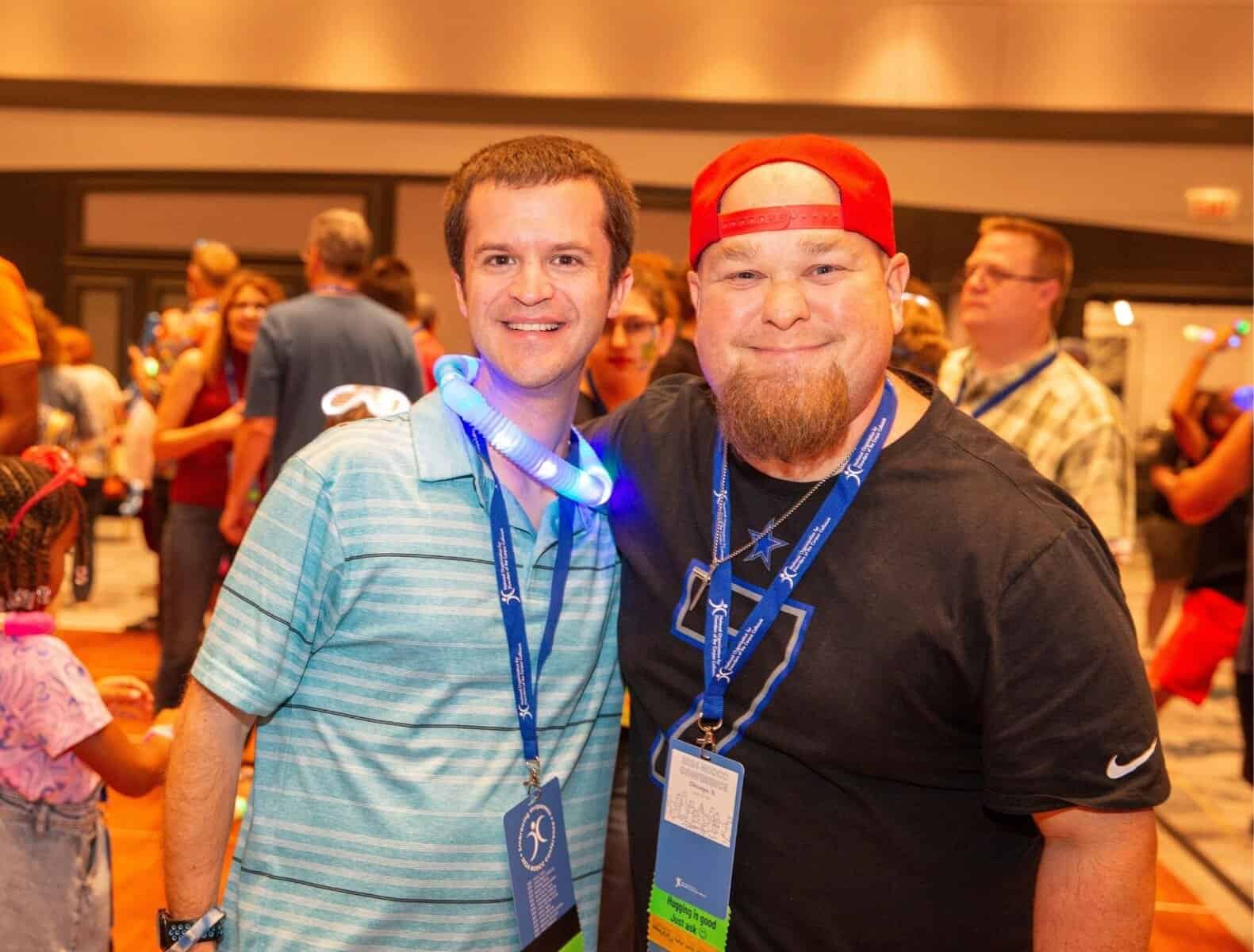Disorders of the Corpus Callosum
Disorders of the corpus callosum are conditions in which the corpus callosum does not develop in a typical manner.
What are Disorders of the Corpus Callosum?
Disorders of the corpus callosum (DCC) are differences in brain development. They happen when the corpus callosum, the part of the brain that connects the two hemispheres, doesn’t form completely (agenesis) or develops differently (dysgenesis). These conditions can only be diagnosed with brain imaging like an MRI, CT scan, or ultrasound.
While the corpus callosum cannot be repaired or replaced, doctors and researchers are working to better understand DCC and find ways to support individuals and families. Studies suggest that about 1 in 2,053 people may have some form of DCC, and with better access to brain scans, more diagnoses are expected in the future.
If you or a loved one has been diagnosed with DCC, you’re not alone. There are many resources and a supportive community here to help.
Corpus Callosum Disorders affect roughly 1 out of 2,053 individuals
Living with a Disorder of the Corpus Callosum (DCC)
Every person with a disorder of the corpus callosum (DCC) is unique. Some may need medical care for conditions like seizures, while others may not require any medical treatment. However, many children with DCC benefit from therapies that help with developmental delays, and some may need support into adulthood for social skills or executive functioning.
Because DCC affects the brain, its impact isn’t always visible. A child with DCC may look like their peers but might struggle with social interactions or developmental milestones. Raising awareness about these “invisible disabilities” can help foster understanding, acceptance, and support for individuals and their families.
While DCC presents challenges, it does not define a person’s potential. With the right support, individuals with DCC can lead fulfilling, meaningful lives and make valuable contributions to their communities.
What Is the Corpus Callosum?
The corpus callosum is the brain’s main connection between the left and right hemispheres. Made up of more than 200 million nerve fibers, it acts like a superhighway, allowing information to quickly travel back and forth between the two sides of the brain.
In disorders of the corpus callosum (DCC), this superhighway is missing (agenesis) or doesn’t form as expected (dysgenesis). Without it, the brain has to reorganize to find new ways to process information, like using smaller side roads instead of a freeway. This can make processing and communication between the two halves of the brain slower or different, leading to challenges in learning, movement, and social interactions.
Even though the brain works differently in individuals with DCC, it is always adapting—finding new routes and solutions to help process information in the best way possible.
How Disorders of the Corpus Callosum (DCC) Develop and What Causes Them
How Do Disorders of the Corpus Callosum (DCC) Develop?
Disorders of the corpus callosum (DCC) occur when the corpus callosum doesn’t develop as expected. Since these are differences in brain structure, they can only be diagnosed using brain imaging such as:
- Ultrasound – Can sometimes detect DCC before birth.
- CT Scan (CAT Scan) – Uses X-rays to create brain images.
- MRI (Magnetic Resonance Imaging) – The most detailed scan to confirm a diagnosis.
When Does the Corpus Callosum Develop?
In a typical pregnancy, the corpus callosum begins forming between weeks 5 and 16, with most of the structure in place by the end of the first trimester. While the basic structure is formed before birth, the nerve fibers continue strengthening and improving efficiency into adolescence. By around age 12, the corpus callosum functions much like it does in adulthood, allowing quick communication between the left and right sides of the brain.
For children with DCC, however, the absence or differences in the corpus callosum mean their brains must find other ways to send information between hemispheres. As a result, developmental differences may become more noticeable as they grow.
What Causes Disorders of the Corpus Callosum?
There is no single cause of DCC, and in many cases, the exact reason is unknown. However, some factors that may affect the development of the corpus callosum include:
- Genetic conditions (e.g., trisomy 8 or 18, Andermann syndrome, Aicardi syndrome)
- Serious prenatal infections or viruses (e.g., rubella)
- Exposure to toxins (e.g., fetal alcohol syndrome)
- Brain structure differences (e.g., cysts that block growth)
Types of Disorders of the Corpus Callosum
DCC can vary from person to person. Some individuals have a completely missing corpus callosum (agenesis of the corpus callosum or ACC), while others have a partially formed (partial ACC) or underdeveloped (hypoplasia) corpus callosum. In some cases, the structure forms abnormally (dysgenesis).
Each person’s experience with DCC is unique, and while challenges exist, many individuals develop their own ways of learning, communicating, and thriving.
Complete Agenesis of the Corpus Callosum (ACC)
If the nerve fibers don’t cross between the hemispheres during that critical prenatal time, they never will. Agenesis (or absence) of the corpus callosum becomes a permanent feature of the individual’s brain. The callosal fibers may have started to grow, but when unable to cross between the hemispheres, they grow toward the back of the same hemisphere where they began. These fibers form what are called Bundles of Probst. Some smaller connections between the hemispheres develop in most individuals with ACC. These are the anterior commissure, posterior commissure, and hippocampal commissure. However, each of these is at least 40,000 times smaller than the corpus callosum. Thus, they cannot completely compensate for the absence of the corpus callosum.
Hypoplasia & Dysgenesis of the Corpus Callosum
Hypoplasia refers to a thin corpus callosum. On a mid-line view of the brain, the structure may extend through the entire area front-to-back as would a typical corpus callosum, but it looks notably thinner. It is unclear in this case if the callosal nerve fibers are fully functional and just limited in number, or if they are both less plentiful and more dysfunctional.
Partial Agenesis of the Corpus Callosum (P-ACC)
In partial ACC, the corpus callosum began to develop, but something stopped it from continuing. Since the corpus callosum develops from front to back, the part of the corpus callosum that is present in partial ACC usually will be toward the front of the brain, with the back portion missing. Partial ACC includes the entire range of partial absence, from absence of only a small portion of callosal fibers to absence of most of the corpus callosum. In P-ACC, the other smaller commissures are usually present.
Co-Occurring Conditions & Genetics
Individuals with a disorder of the corpus callosum (DCC) may also experience other medical or developmental conditions that occur alongside the primary diagnosis. Understanding these co-occurring conditions can provide greater insight into diagnosis, care, and support options. For an overview of structural conditions, associated complications, and genetic disorders often linked to DCCs, click HERE.
Understanding Behavior in Individuals with DCC
Every person with a disorder of the corpus callosum (DCC) is unique, and their abilities and challenges can vary widely. Below is an overview of common behavioral traits seen in individuals with DCC—but it’s important to remember that not everyone will experience the same symptoms or at the same level.
Because some of these behaviors overlap with other conditions like ADHD, autism spectrum disorder, nonverbal learning disabilities, or psychiatric disorders, DCC is sometimes misidentified. However, unlike these conditions, which are diagnosed based on behavior, DCC is a structural difference in the brain that can only be confirmed through an MRI.
While some behavioral diagnoses may describe certain traits of a person with DCC, they don’t explain the underlying cause. Understanding the connection between brain structure and behavior can help individuals with DCC get the right support and strategies to thrive.
Common Challenges in Individuals with DCC
Individuals with disorders of the corpus callosum (DCC) experience a wide range of abilities, and challenges can vary from subtle to significant. Below are some areas where they may need extra support:
- Developmental Delays – Some children may take longer to reach milestones like walking, talking, or reading, though progress happens at their own pace.
- Motor Coordination – Activities requiring both sides of the body, such as swimming, bike riding, tying shoes, or driving, can be more challenging. Clumsiness and difficulty with balance are also common.
- Social & Communication Differences – Understanding social cues, humor, sarcasm, and figurative language can be difficult. Individuals may be kind and eager to connect but struggle with interpreting emotions, predicting consequences, or recognizing when someone is being insincere.
- Problem-Solving & Complex Tasks – Multi-step activities like budgeting, math, science, or handwriting may require extra time and support. Some individuals may also find it harder to adapt to unexpected changes.
- Self-Awareness & Social Insight – Understanding their own behavior and recognizing social challenges can be difficult, sometimes leading to unintentional social missteps or vulnerability to influence from others.
- Sensory Differences – Sensitivity to textures, sounds, or certain types of touch is common, though many also have a high tolerance for pain.
While these challenges may become more noticeable with age, especially in middle school and beyond, the right support and strategies can help individuals with DCC build confidence and navigate daily life successfully.
Strengths:
Cognitive & Learning Strengths
- Strong rote memory – Many individuals with DCC have excellent recall for facts, routines, and sequences.
- Attention to detail – They may excel at noticing patterns, rules, or small details.
- Creative problem-solving – Some individuals develop unique strategies to navigate challenges.
Social & Emotional Strengths
- Kind and empathetic – Many individuals with DCC are warm, caring, and deeply compassionate.
- Honest and genuine – They often express themselves in a straightforward and sincere way.
- Eager to connect – Many enjoy making friends and forming relationships, even if social cues can be challenging.
Personal Traits & Life Skills
- Resilient and determined – Many individuals with DCC work hard to overcome challenges and develop independence.
- Loyal and dependable – They often build strong connections with those they trust.
- Curious and enthusiastic – Many have a love for learning, exploring interests, and engaging in hobbies.
FAQs
What are the common developmental problems that may co-occur with disorders of the corpus callosum?
It is difficult to predict exactly the milestones and challenges a person diagnosed with a DCC will have. Some parents notice milestones are not met as infants or toddlers. Other parents notice differences as a child progress through the early years of school. Behaviorally individuals with DCC may fall behind their peers in social and problem-solving skills in elementary school or as they approach adolescence. In typical development, the fibers of the corpus callosum become more efficient as children approach adolescence. At that point children with an intact corpus callosum show rapid gains in abstract reasoning, problem solving, and social comprehension. Although a child with DCC may have kept up with his or her peers until this age, as the peer-group begins to make use of an increasingly efficient corpus callosum, the child with DCC falls behind in mental and social functioning. In this way, the behavioral challenges for individuals with DCC may become more evident as they grow into adolescence and young adulthood.
Who can diagnose a DCC?
What about stem-cell research?
Will DCC get worse?
What kind of treatments or therapies does someone need or what treatments will help?
The early years of childhood present a crucial window for developing neural pathways in the brain. Early intervention after a diagnosis in infant or young child is very important. Local school districts offer early intervention services or search for private clinics or resources for birth to age 3 in your area. Your pediatrician should be able to put you in contact with local service providers. Some of the services you may receive include PT (Physical Therapy), OT (Occupational Therapy) & SPI (Speech Therapy). Early intervention resources can be found at the National Early Childhood TA Center website. Contact the Department of Developmental Disabilities in your area for information about respite and/or rehabilitation care services for your child. Typically, you need to schedule an appointment for the intake meeting that determines qualifying for services.
What is the difference between a structural diagnosis (like DCC) and behavior syndromes (such as autism)?
The presence of a known brain abnormality does not preclude the assignment of a behavioral diagnosis. At this point, there is limited research regarding best treatment strategies for DCC, so it is most sensible to pursue validated treatments for an individual’s behavior pattern (regardless of whether DCC has been diagnosed or not).
What kind of life will someone with DCC live?
Unfortunately, there is no perfect prediction about the challenges or limitations that a child may face. One neurologist told a parent in our community “only you will limit what your child will do.” We like that sentiment as encouragement to parents to celebrate the milestones and appreciate the abilities that your child has. There are many interventions and therapies that can help your child depending on the challenge and needs, especially early childhood interventions.
What causes DCC?
Some of the conditions in which DCC is usually present are: Aicardi Syndrome, Shapiro Syndrome, Acrocallosal Syndrome, Mowat-Wilson Syndrome, and Toriello Carey Syndrome. Some of the conditions in which DCC is sometimes present are: Fetal Alcohol Syndrome, intrauterine infections, maternal riboflavin/ folate/ or niacin deficiency, Dandy-Walker Syndrome, Andermann Syndrome, Arnold-Chiari II Malformation, Holoprosencephaly, Hirschsprung Disease, Occulo-Cerebro-Cutaneous Syndrome, Menkes Disease, Hydrocephalus, and others.
Why does my child have DCC?
Genetic testing may reveal a genetic abnormality or syndrome that is the underlying cause of the DCC. In these cases, the parents or the individual with DCC will want to consult a genetic counselor prior to becoming pregnant with another child. In the absence of an identified genetic abnormality, it is extremely difficult to find a specific cause of DCC. Multiple possible causes appear to exist, and genetic testing does not always reveal what that cause might be. If it is not genetic, it was caused by something that happened during the first trimester of pregnancy. While it is understandable that parents will want to know “why this happened,” in many cases they may never know. Therefore, it may be important to shift the focus from asking “why?” to asking, “what can we do to cope with the diagnosis?” and “how can we best help our child?”





